语法讲义
- 格式:doc
- 大小:35.00 KB
- 文档页数:2


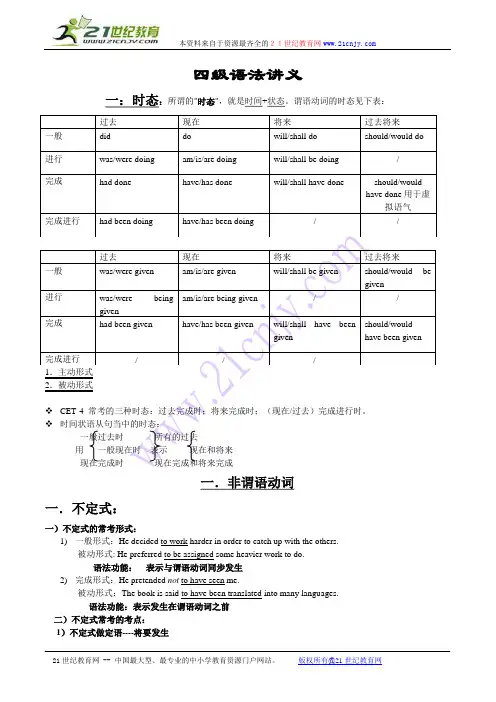
四级语法讲义一:时态:所谓的"时态",就是时间+状态。
谓语动词的时态见下表:1.主动形式2.被动形式CET-4 常考的三种时态:过去完成时;将来完成时;(现在/过去)完成进行时。
时间状语从句当中的时态:一般过去时 所有的过去 用 一般现在时 表示 现在和将来 现在完成时 现在完成和将来完成一.非谓语动词一.不定式:一)不定式的常考形式:1) 一般形式:He decided to work harder in order to catch up with the others. 被动形式: He preferred to be assigned some heavier work to do.语法功能: 表示与谓语动词同步发生2) 完成形式:He pretended not to have seen me. 被动形式:The book is said to have been translated into many languages.语法功能:表示发生在谓语动词之前 二)不定式常考的考点:1)不定式做定语----将要发生过去 现在 将来 过去将来 一般 diddowill/shall do should/would do进行 was/were doing am/is/are doing will/shall be doing /完成had donehave/has donewill/shall have doneshould/would have done 用于虚拟语气完成进行 had been doing have/has been doing //过去现在将来过去将来 一般 was/were given am/is/are givenwill/shall be givenshould/would be given进行 was/were being givenam/is/are being given//完成had been givenhave/has been givenwill/shall have been given should/would have been given完成进行 / //2)不定式做状语----目的3)不定式充当名词功能---To see is to believe.三)不定式的省略1)感官动词see, watch, observe, notice, look at, hear, listen to, smell, taste, feel+ do表示动作的完整性,真实性;+ doing表示动作的连续性,进行性I saw him work in the garden yesterday.昨天我看见他在花园里干活了。

一、时态、语态时态、语态需要掌握的要点:1.表达将来时的形式:(1)在时间、条件、让步从句中,一般现在时代替将来时,但要注意区别从句的类型,如:I’ll tell him when you will ring again. 我告诉他你什么时候再来电话。
(宾语从句)比较:I’ll tell him when you ring again.你再打电话时我告诉他。
(状语从句)(2)在make sure, make certain, see (to it) 后的that从句中,谓语动词用一般现在时代替将来时,如:See to it that you include in the paper whatever questions they didn’t know the answer to last time.(include 不能用will include或其他形式) 2.完成时是时态测试的重点,注意与完成时连用的句型和时间状语:(1)by/between/up to/till +过去时间、since、by the time/when +表示过去发生情况的从句,主句用过去完成时。
如:We had just had our breakfast when an old man came to the door.Between 1897 and 1919 at least 29 motion pictures in which artificial beings were portrayed had been produced.(表示1919年时已发生的情况) (2)by +将来时间、by the time/ when +谓语动词是一般现在时的从句,主句用将来完成时。
如:By the time you arrive in London, we will have stayed in Europe for two weeks.I hope her health will have improved greatly by the time we come back next year.(3)by now、since +过去时间、in/during/for/over/the past/last few(或具体数字)years/days/months,主句用现在完成时,如:The changes that had taken place in air travel during the last sixty years would have seemed completely impossible to even the most brilliant scientists at the turn of the 19th century.但在it is +具体时间since/before这一句型中,主句更多的时候不用完成时。

(内部资料) 2018.1目录第一讲名词第二讲冠词第三讲代词第四讲数词第五讲介词第六讲形容词和副词第七讲连词第八讲情态动词第九讲非谓语动词第十讲时态第十一讲被动语态第十二讲祈使句、倒装句、反意疑问句和感叹句第十三讲宾语从句第十四讲定语从句第十五讲状语从句第十六讲主谓一致第十七讲情景交际第十八讲词义辨析附录I 重点短语概述一、概述语法是研究词形变化和句子结构的科学,研究词形变化的部分成为词法(名词的数、格,动词的时态、语态),研究句子结构的部分称为句法(句子成分、语序,句子种类)。
二、英语词类词类英语作用在句中成分例词1名词n.表示人或物的名称主、宾、表、定、同位mother, son 2形容词adj.表示人或物的特征定、表、补、状big, small 3数词num.表示数目或顺序主、宾、nine, first 4代词pron.代替名词,数词主语宾语定语he, him, his 5动词v.表示动作或状态谓come, write 6副词adv.表示动作特征或性状特征状、表very, slowly 7冠词art.用在名词前说明其意义不做成分a, an, the8介词prep.用在名代前说明它与别的词之间的关系不做成分for, from, to 9连词conj.用来连接词与词或句与句不做成分and, but, if 10感叹词interj.表示说话时的感情或口气不做成分oh, ow三、句子成分句子中有两个最重要最基本的成分,主语和谓语。
除了主语和谓语,句子有时还有其他成分,宾语、定语、状语、表语等。
主语:一般位于句首,说明所要讲述的对象或主体,表示要说的“谁”或“什么”,一般由名词、代词或名词性的词类、短语或从句充当。
We often practise speaking English after class.Your father’s car is new.Watching English films is a good way to learn English.谓语:位于主语之后,说明主语的情况(动作或状态)---“做什么”“是什么”“怎么样”。
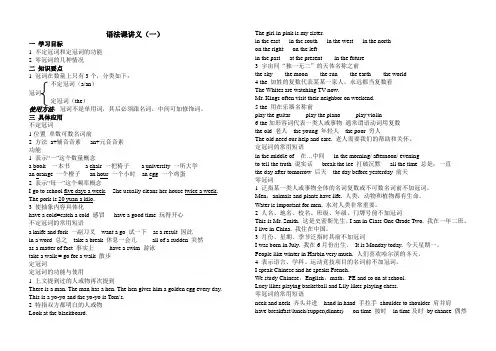
语法课讲义(一)一学习目标1 不定冠词和定冠词的功能2 零冠词的几种情况二知识要点1 冠词在数量上只有3个,分类如下:不定冠词(a/an)冠词定冠词(the):冠词不是单用词,其后必须跟名词,中间可加修饰词。
三具体应用不定冠词1位置单数可数名词前2 方法a+辅音音素an+元音音素功能1 表示“一”这个数量概念a book 一本书 a chair 一把椅子 a university 一所大学an orange 一个橙子an hour 一个小时an egg 一个鸡蛋2 表示“每一”这个频率概念I go to school five days a week. She usually cleans her house twice a week. The pork is 20 yuan a kilo.3 使抽象内容具体化have a cold=catch a cold 感冒have a good time 玩得开心不定冠词的常用短语a knife and fork 一副刀叉want a go 试一下as a result 因此in a word 总之take a break 休息一会儿all of a sudden 突然as a matter of fact 事实上have a swim 游泳take a walk = go for a walk 散步定冠词定冠词的功能与使用1 上文提到过的人或物再次提到There is a man. The man has a hen. The hen gives him a golden egg every day. This is a yo-yo and the yo-yo is Tom’s.2 特指双方都明白的人或物Look at the blackboard. The girl in pink is my sister.in the east in the south in the west in the northon the right on the leftin the past at the present in the future3 宇宙间“独一无二”的天体名称之前the sky the moon the sun the earth the world4 the 加姓的复数代表某某一家人,永远都当复数看The Whites are watching TV now.Mr. Kings often visit their neighbor on weekend.5 the 用在乐器名称前play the guitar play the piano play violin6 the加形容词代表一类人或事物通常谓语动词用复数the old 老人the young 年轻人the poor 穷人The old need our help and care. 老人需要我们的帮助和关怀。
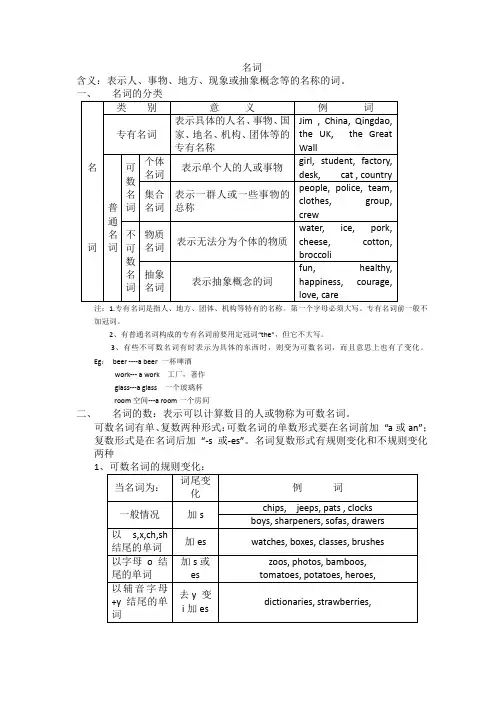
名词含义:表示人、事物、地方、现象或抽象概念等的名称的词。
注:1.专有名词是指人、地方、团体、机构等特有的名称。
第一个字母必须大写。
专有名词前一般不加冠词。
2、有普通名词构成的专有名词前要用定冠词“the”,但它不大写。
3、有些不可数名词有时表示为具体的东西时,则变为可数名词,而且意思上也有了变化。
Eg : beer ----a beer 一杯啤酒work--- a work 工厂,著作glass---a glass 一个玻璃杯room 空间---a room 一个房间二、 名词的数:表示可以计算数目的人或物称为可数名词。
可数名词有单、复数两种形式:可数名词的单数形式要在名词前加 “a 或an”;复数形式是在名词后加 “-s 或-es”。
名词复数形式有规则变化和不规则变化两种12. 可数名词复数的不规则变化① 改变单数名词中的元音字母eg. man--men, woman—women, tooth—teeth, foot—feet, mouse--mice② 单复数同形eg. Chinese-Chinese, deer-deer, fish-fish, sheep-sheep,③ 由man 和woman构成的合成词, 每个名词都要变复数eg. a man doctor— men doctors, a woman teacher--women teachers 注: 有些名词表示一种物体具有不可分割的相同的两部分,在使用时只有复数形式eg. trousers, clothes, glasses, shorts, etc;有些名词从形式上看是复数, 实际上是单数(其后的谓语动词要用单数).eg. maths , physics, politics, news3. 不可数名词:表示不能计算数目的人或物,称为不可数名词。
他们前面不能用a/an,没有复数形式。
物质名词和抽象名词都属于不可数名词。
不可数名词一般只有单数形式, 但有其特殊用法:(1)同一个词,变成复数形式, 意义不同。
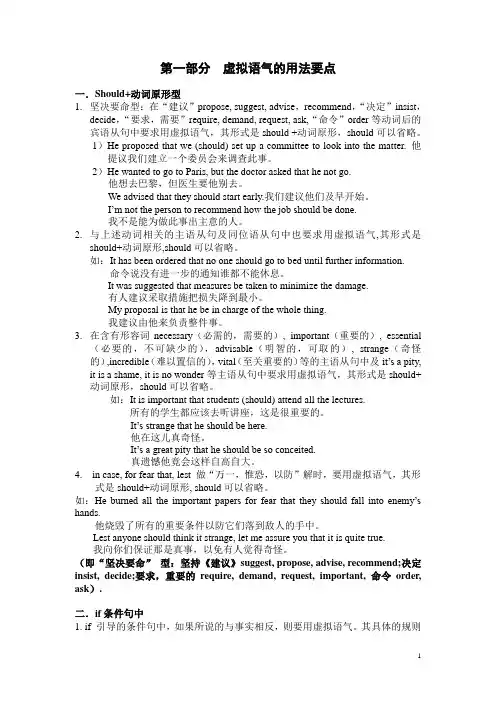
第一部分虚拟语气的用法要点一.Should+动词原形型1.坚决要命型:在“建议”propose, suggest, advise,recommend,“决定”insist,decide,“要求,需要”require, demand, request, ask,“命令”order等动词后的宾语从句中要求用虚拟语气,其形式是should +动词原形,should可以省略。
1)He proposed that we (should) set up a committee to look into the matter. 他提议我们建立一个委员会来调查此事。
2)He wanted to go to Paris, but the doctor asked that he not go.他想去巴黎,但医生要他别去。
We advised that they should start early.我们建议他们及早开始。
I’m not the person to recommend how the job should be done.我不是能为做此事出主意的人。
2.与上述动词相关的主语从句及同位语从句中也要求用虚拟语气,其形式是should+动词原形,should可以省略。
如:It has been ordered that no one should go to bed until further information.命令说没有进一步的通知谁都不能休息。
It was suggested that measures be taken to minimize the damage.有人建议采取措施把损失降到最小。
My proposal is that he be in charge of the whole thing.我建议由他来负责整件事。
3.在含有形容词necessary(必需的,需要的), important(重要的), essential(必要的,不可缺少的),advisable(明智的,可取的), strange(奇怪的),incredible(难以置信的),vital(至关重要的)等的主语从句中及it’s a pity, it is a shame, it is no wonder等主语从句中要求用虚拟语气,其形式是should+动词原形,should可以省略。
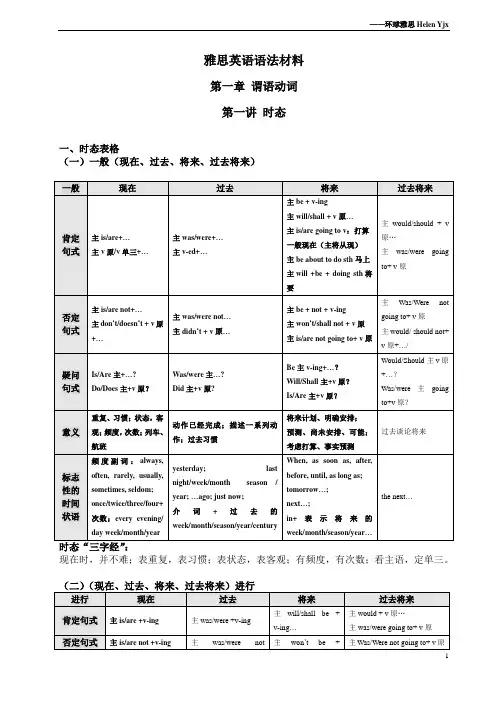
雅思英语语法材料第一章谓语动词第一讲时态一、时态表格(一)一般(现在、过去、将来、过去将来)现在时,并不难;表重复,表习惯;表状态,表客观;有频度,有次数;看主语,定单三。
(三)(现在、过去、将来、过去将来)完成(四)(现在、过去、将来、过去将来)完成进行二、基本时态演练Listening to the following conversation.(一) Task One: fill in the blanks.1. Interviewer: Your name?Peter: Peter __________. (1)2. Interviewer: ________ (2) you work or _________ (3) you a student?Peter: I’m studying really hard for my exams this month—I’m doing math’s at university—but I also________ (4) my parents out. They own a _________ (5) and I ________ (6) there as a waiter in the evenings, so I ____________ (7) a lot of free time during the week.My mom is always saying that I _____________ (8) enough in the restaurant! But I do manage to find some free time most days.3. Interviewer: Can you look at the _____ (9) and tell me whether you do any of these things and if so, how ____ (10)?Peter: I love music and I’m learning to play the piano. I ______ (11) really early and practice for an hour or so just about every day. I also play the guitar in a band with some other friends. We used to practice together at least _____________ (12) a week but these days we only manager to meet about once __________________ (13).4. Interviewer: What about the next thing on the list? -_________________ (14)?Peter: Well, I used to play them all the time but now I’m too busy studying and I _______ (15) miss them at all.5. Interviewer: Do you use a computer for other things?Peter: I use the Internet just about ________ (16) for my studies. And I also use it to _____________ (17) my friends and my family. My cousin is living in Thailand at the moment and he _______ (18) me regular emails to let me know how much fun he’s having! He’s always visiting exciting places.6. Interviewer: Now, how about _________________ (19)?Peter: Actually, I joined the local football team when I was at school and I still play _______________ (20) provided I can get to training. I much prefer playing football to watch it on TV, though I do ______________ (21) watch a match if there’s a big final or something.7. Interviewer: What about going to watch live matches?Peter: I’d love to be able to afford to go every week because I ____________ (22) my local team, but students don’t ____________ (23) have much money, you know! I can remember the ___________ (24) I went to a live match. Oh, sorry, I can see my friends—I ____________ (25)go now!(二)Task TwoRead through the conversation and find out:1. Present simple sentences:2. Present continuous:3. Past simple sentences:三、时态改错1. People should act according to what they are believing.2. In general, I think our government spent too much money on space travel.3. Nowadays, many people in my country have sent their children to single-sex schools.4. These days, more and more people traveling to very distant places for their holidays.5. I am hoping it is not too late to save the environment.6. The female hen laying on average 5 or 6 eggs per week.7. Younger drivers is more likely to be involved in a car accident.8. Most doctors are agreeing that the only way to lose weight is by doing more exercise.第二讲语态一、被动语态的形式二、被动语态使用情景(一)一般说来,当强调动作承受者,不必说出执行者或含糊不清的执行者时,多用被动式1. I agree with the statement that there should be no government restriction on creative artists who express themselves in the way they do and that they must be given freedom for the same. (IELTS 4, Band 7, p167)2. There is almost everything good in what is given to us through the media world which is made up of artists. (同上)3. In conclusion, I strongly agree with that children should be taught to cooperate rather than compete. (IELTS 5, Band 6, p167)4. It was opened in the year 1863, and it is already 140 years old. (IELTS 5, Band 7, p168)(二)在描述事件和客观事实的时候,被动语态用得更多1. The use of electricity in England is indispensed with. (IELTS 4, Band 6, p164)2. Demand for electricity in England during typical days in winter and summer is illustrated in the graph. (同上)3. The use of average English home is shown in the pie chart. (同上)(三)主语是泛指很多人或者大部分人这个方面1. A more dramatic rise is predicted between 2030 and 2040 in Japan, by which it is thought thatthe proportion of elderly people will be similar in the three countries. (IELTS 5, model answer, p162)2. It can be argued that…It is advised/believed/universally accepted/generally recognized that…It is said/reported/estimated that…(四)当上下文已经说明了动作执行者时:A law was introduced to help protect people in this situation.(五)动作的执行者并不重要时:In the factory, the shoes are cleaned and packed into boxes ready for sale.(六)需要体现动作的执行者时,加by-短语:A lot of waste materials could be recycled by large manufacturers.三、剑指考试1. To enrich vocabulary, we should read more authentic materials.可以改为:(1)(2)(3)2. It is important for nations all over the world to work hard together to control the environmental pollution.可以改为:3. I am not sure whether all the college graduates can find jobs after graduation.可以改为:4. 用适当的动词形式完成下列句子:(1)My home _____________ (locate) in the western part of the city.(2)These funds can _____________ (give) to the poorer people to help them.(3)We _____________ (not tell) that the rules had changed.(4)Children need to _____________ (teach) the correct way to behave in public.5. 句子改错:(1)The house was sell for over a million dollars.(2)The class has allowed to eat in the staff dining room during the renovations.(3)The potatoes carry along a conveyor belt to a room where they wash and peel. (4)The teacher told to take her class out of the school if the fire bell rang.(5)Smoking don’t allow in any part of the aeroplane.(6)The museum was being renovating when we were there, so we could not visit it. (7)Bus tickets can buy at any newsagents.(8)New employees have instructed not to operate the photocopier until they are trained.6. 把下面的句子改成被动语态,并决定是否需要带by-短语(1)A factory worker checks each box for quality.(2)The government does not permit children under 16 to work.(3)The washing machine is washing your clothes at the moment.(4)A mechanic will repair your car this afternoon.(5)The agent has sold our house at last.(6)Something tore the back of my coat.(7)The employer pay off the staff more for working at the weekend.(8)Burning tires give off highly toxic chemicals.第三讲虚拟语气请欣赏下列一首诗歌:If you were a teardrop in my eye,For fear of losing you, I would never cry.And if the golden sun should cease to shine its light,Just one smile from you would make my whole world bright.一、虚拟语气基本句型1. 与现在事实相反(1) If she were sick, she could stay at home and have a rest today.(2) If you watched more and talked less, we would both enjoy our film.2. 与过去事实相反(1) If they had studied earlier, they would have passed the IELTS.(2) Helen would have graduated with her class if she had been able to meet all the requirements in time.3. 与将来事实相反(1) If it snowed tomorrow, I would go skiing.(2) If it should snow tomorrow, I would go to make a snowman in front of our dormitory.(3) If you were to see your tutor, what would you tell him?4.错综的虚拟语气(1) If I were you, I wouldn’t have told that to her. (时间错综:从句现在,主句过去)(2) Had I taken my umbrella with me in the morning, I should not be wet now. (时间错综:从句过去,主句现在)5.虚拟语气的倒装可以把条件句中的if 省略掉,同时把should, were, had 等助动词提前,构成倒装句。
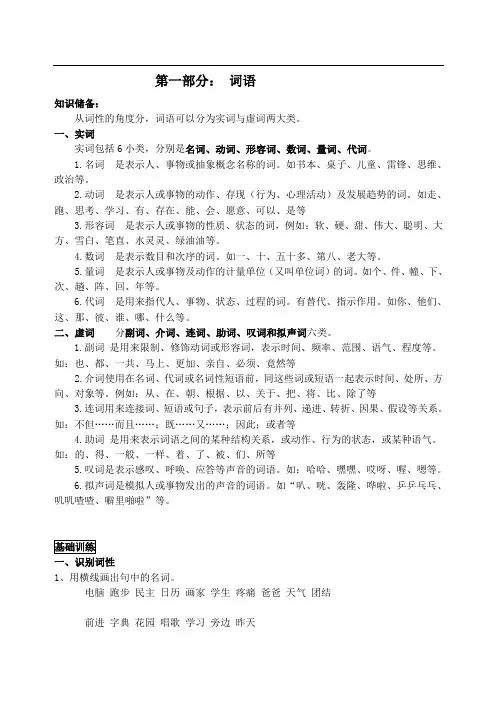
第一部分:词语知识储备:从词性的角度分,词语可以分为实词与虚词两大类。
一、实词实词包括6小类,分别是名词、动词、形容词、数词、量词、代词。
1.名词是表示人、事物或抽象概念名称的词。
如书本、桌子、儿童、雷锋、思维、政治等。
2.动词是表示人或事物的动作、存现(行为、心理活动)及发展趋势的词。
如走、跑、思考、学习、有、存在、能、会、愿意、可以、是等3.形容词是表示人或事物的性质、状态的词,例如:软、硬、甜、伟大、聪明、大方、雪白、笔直、水灵灵、绿油油等。
4.数词是表示数目和次序的词。
如一、十、五十多、第八、老大等。
5.量词是表示人或事物及动作的计量单位(又叫单位词)的词。
如个、件、幢、下、次、趟、阵、回、年等。
6.代词是用来指代人、事物、状态、过程的词。
有替代、指示作用。
如你、他们、这、那、彼、谁、哪、什么等。
二、虚词分副词、介词、连词、助词、叹词和拟声词六类。
1.副词是用来限制、修饰动词或形容词,表示时间、频率、范围、语气、程度等。
如:也、都、一共、马上、更加、亲自、必须、竟然等2.介词使用在名词、代词或名词性短语前,同这些词或短语一起表示时间、处所、方向、对象等。
例如:从、在、朝、根据、以、关于、把、将、比、除了等3.连词用来连接词、短语或句子,表示前后有并列、递进、转折、因果、假设等关系。
如:不但……而且……;既……又……;因此;或者等4.助词是用来表示词语之间的某种结构关系,或动作、行为的状态,或某种语气。
如:的、得、一般、一样、着、了、被、们、所等5.叹词是表示感叹、呼唤、应答等声音的词语。
如:哈哈、嘿嘿、哎呀、喔、嗯等。
6.拟声词是模拟人或事物发出的声音的词语。
如“叭、咣、轰隆、哗啦、乒乒乓乓、叽叽喳喳、噼里啪啦”等。
一、识别词性1、用横线画出句中的名词。
电脑跑步民主日历画家学生疼痛爸爸天气团结前进字典花园唱歌学习旁边昨天2、用横线画出下面的动词。
吃唱增加想法上课念头美术出来睡觉马虎国家希望能够担心考试拍现象他们愿意分析3、用横线画出下列语段中的形容词。
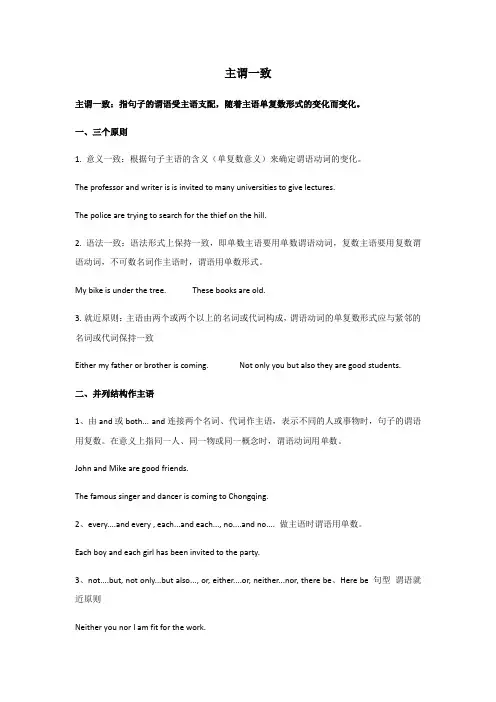
主谓一致主谓一致:指句子的谓语受主语支配,随着主语单复数形式的变化而变化。
一、三个原则1. 意义一致:根据句子主语的含义(单复数意义)来确定谓语动词的变化。
The professor and writer is is invited to many universities to give lectures.The police are trying to search for the thief on the hill.2. 语法一致:语法形式上保持一致,即单数主语要用单数谓语动词,复数主语要用复数谓语动词,不可数名词作主语时,谓语用单数形式。
My bike is under the tree. These books are old.3.就近原则:主语由两个或两个以上的名词或代词构成,谓语动词的单复数形式应与紧邻的名词或代词保持一致Either my father or brother is coming. Not only you but also they are good students.二、并列结构作主语1、由and或both... and连接两个名词、代词作主语,表示不同的人或事物时,句子的谓语用复数。
在意义上指同一人、同一物或同一概念时,谓语动词用单数。
John and Mike are good friends.The famous singer and dancer is coming to Chongqing.2、every....and every , each...and each..., no....and no.... 做主语时谓语用单数。
Each boy and each girl has been invited to the party.3、not....but, not only...but also..., or, either....or, neither...nor, there be、Here be 句型谓语就近原则Neither you nor I am fit for the work.There is a pen,a pencil,a knife and three books on the desk.Here are some flowers and a card.三、单一主语:由一个中心词或短语充当的主语不定代词作主语:1.当作主语的名词前有each,neither,either,every修饰或each,neither,either作主语时,谓语动词用单数。
英语语法讲义(精简纲要版)第一章:词类、句子成分、基本句型、构词法(英语的树干,语法分析的精髓)一、词类1、名词(n.):表示人、事物、地点或抽象概念的名称。
如:boy,morning,bag,ball,class,orange.2、代词(pron.):主要用来代替名词。
如:who,she,you,it.3、形容词(adj.):表示人或事物的性质或特征。
如:good,right,white,orange.4、数词(num.):表示数目或事物的顺序。
如:one,two,three,first,second,third,fourth.5、动词(v.):表示动作或状态。
如:am,is,are,have,see.6、副词(adv.):修饰动词、形容词或其他副词,说明时间、地点、程度等。
如:now,very,here,often,quietly.7、冠词(art.):用在名词前,帮助说明名词。
如:a,an,the.8、介词(prep.):表示它后面的名词或代词与其他句子成分的关系。
如in,on,from,above,behind.9、连词(conj.):用来连接词、短语或句子。
如and,but,before.10、感叹词(interj.):表示喜、怒、哀、乐等感情。
如:oh,well,hi,hello.二、句子成分【重点掌握英语基本句型中的涉及到的六大成分:主谓宾;定状补】1、主语句子所要说的人或事物,回答是“谁”或者“什么”。
通常用名词或代词担任。
如:I’m Miss Green.(我是格林小姐)2、谓语动词说明主语的动作或状态,回答“做(什么)”。
主要..由动词担任。
【思考】:动词等于谓语吗?如:Jack cleans the room every day.(杰克每天打扫房间)Lily is beautiful.(莉莉是漂亮的)3、表语在系动词之后,说明主语的身份或特征,回答是“什么”或者“怎么样”。
英语语法袁鹤飞Prsent Tense1) 经常性或习惯性的动作e.g.: I leave home for school at 7 every morning.2)客观真理,客观存在,科学事实e.g. The earth moves around the sun.Shanghai lies in the east of China3) 格言或警句中e.g.: Pride goes before a fall. 骄者必败。
•注意:此用法如果出现在宾语从句中,即使主句是过去时,从句谓语也要用一般现在时。
•Eg.: Columbus proved that the earth is round.4) 现在时刻的状态、能力、性格、个性e.g.: I don’t want so much.Ann Wang writes good English but doesnot speak well.Progressive Tense⏹ 1. 现在进行时⏹1)现在进行时表示现在正在进行的动作,由“ to be十现在分词”构成,另外“系动词十介词或副词”也表示进行时的意义.例如:What are you doing?The bridge is under construction.⏹2)表示感觉,愿望和状态的某些动词如have,be,hear,see,like等词一般不用进行时.⏹2.过去进行时的用法过去进行时表示过去某一时刻、某一阶段正进行的动作,由“ was(were)十现在分词”构成.例如:In 1980 he was studying in a university.He was reading a novel when I came in.⏹The fifth generation computers, with artificial intelligence, _______and perfected now.A) developed B) have developed⏹C) are being developed D) will have been developed⏹ C⏹具有人工智能的第五代计算机目前正在开发和完善之中"。
现代汉语语法讲义北京语言大学郑贵友第一章语法概说一、语法和语法学二、语法单位三、句子成分四、句子分析——分析句子的两种方法第二章词类一、词类的含义及词类划分的目的二、词类划分的标准三、词的一级分类和再分类四、各类实词名词动词形容词区别词数词量词代词副词/象体词五、各类虚词介词连词助词语气词六、兼类问题第三章短语一、定义二、短语的种类三、短语的构成手段四、简单短语和复杂短语五、单义短语和多义短语六、自由短语和固定短语七、短语和词宏观上的同与异第四章句子成份一、句子成分的性质二、主语、谓语主语的语法构成主语的语义类型谓语的语法构成三、动语、宾语动语的语法构成有宾动词无宾动词宾语的语法构成宾语的语义类型四、定语五、状语六、补语补语的语法构成补语的语义类型宾语、补语的顺序数量宾语和数量补语七、中心语八、独立语第五章单句一、基本概念二、句型确定的原则和方法三、主谓句主谓谓语句双宾语句连动句兼语句存现句“把”字句“被”字句“是”字句“有”字句“所”字句四、非主谓句五、单句和短语第六章歧义分析一、歧义的含义及歧义研究的目的二、歧义的种类(1)同音造成的歧义同形造成的歧义一词多义造成的歧义词兼类造成的歧义语义关系不同造成的歧义三、歧义的种类(2)第七章复句一、复句的含义二、复句中的关系词语三、复句的分类四、广义的并列关系五、广义的因果句因果关系目的关系假设关系条件关系六、广义的转折句七、复句的扩充八、复句的紧缩第一章语法概说一、语法和语法学(一)语法1.语法的含义及其作用(1)语法的含义语法,是语言中的词、短语、句子的构造规律。
语言有三个要素,语音、词汇和语法。
其中,语音是由人的发音器官发出的、表达一定意义的声音,是语言的物质外壳。
词汇,是语言中的语素、词和固定短语以及现成话的集合,是语言的建筑材料。
而语法则是语言“建筑体”的建筑法则。
西方传统语言学认为,语法包括两个大的方面:词法和句法。
词法,主要涉及词的构成、词的分类和词形变化等内容。
第四章句子成分一.句子成分的性质(一)配对性句子结构中的直接构成成分,往往是两两相对的,是同现的,相互依存的,这就是句子成分的配对性。
句子成分的配对性通常体现在,具有直接关系的句子成分之间往往是对应关系:句子成分配对性的特点是:具有配对关系的句子成分之间是同现的,相互依存的,离开了一方,另外一方也就无所谓存在了。
这一点,在前边的“语法概说”中,已经有所表述,这里不再讨论。
(二)应对性句子成分的应对性,指的是某些句子成分之间可以互易位置,而句子的意思基本不变。
汉语句子成分应对性通常体现在以下几种情况。
1.主—宾应对:主语、宾语互换位置而句子的意思基本不变。
如:①三个人坐一条凳子。
→一条凳子坐三个人。
②西昌通火车了。
→火车通西昌了。
③自古英雄出少年。
→自古少年出英雄。
2.定—中应对:句子中的定语和中心语互换位置而句子的意思基本不变。
如:①水汪汪的眼睛。
→眼睛水汪汪的。
②朵朵白云,阵阵春风。
→白云朵朵,春风阵阵。
3.状—中应对:句子中状语和中心语互换位置而句子的意思基本不变:①你错写了几个字。
→你写错了几个字。
②四周出奇地肃静。
→四周肃静得出奇。
③车子很慢很慢地开着。
→车子开得很慢很慢。
4.主—谓应对:句子中的主语、谓语互换位置而句子的基本意思不变。
如:①一斤白菜三元钱。
→三元钱一斤白菜。
②一张死契六十块大洋。
→六十块大洋一张死契。
上述各种应对关系的事实都是存在的,语法研究要做的是:进一步找到上述各种易位的条件二.主语、谓语(一)主语的语法构成总体上说,可以充当汉语主语的语言成分很多。
在汉语的词类中,除了副词、叹词和各种虚词之外,其他各类实词和词组都可以充当主语。
就此而言,汉语的“主语”似乎是比较讲究“民主”的——汉语的主语不是“名词性成分”的专利。
从具体情况来看,汉语主语通常由以下各种成分来充当。
1.名词性成分充当主语。
这是汉语最为常见的主语构成形式。
如:①他松了一口气。
②小王走了。
③母亲和宏儿都睡着了。
高一英语语法讲义一、句子成分及简单句五种基本句型一、句子成分(一)句子成分的定义:构成句子的各个部分叫做句子成分。
句子成分有主要成分和次要成分;主要成分有主语和谓语;次要成分有表语、宾语、定语、状语、补足语和同位语。
(二)主语:主语是一个句子所叙述的主体,一般位于句首。
但在there be结构、疑问句(当主语不是疑问词时)和倒装句中,主语位于谓语、助动词或情态动词后面。
主语可由名词、代词、数词、不定式、动名词、名词化的形容词和主语从句等表示。
例如:During the 1990s, American country music has become mo re and more popular.(名词)We often speak English in class.(代词)One-third of the students in this class are girls.(数词)|To swim in the river is a great pleasure.(不定式)Sm oking does harm to the health.(动名词)The ri ch should help the poor.(名词化的形容词)When we are going to have an English test has not been decided.(主语从句)It is necessary to master a foreign language.(it作形式主语,真正的主语为后面的不定式)(三)谓语:谓语说明主语所做的动作或具有的特征和状态。
动词在句中作谓语,一般放在主语之后。
谓语的构成如下:1、简单谓语:由一个动词或动词短语构成。
如:He practices running every morning.2、复合谓语:(1)由情态动词或其他助动词加动词原形构成。
如:You may keep the book for two weeks. He has caught a bad cold. (2)由系动词加表语构成。
高考英语基本句型英语中常见的句型有以下五种:1、主语 + 谓语2、主语 + 谓语 + 宾语3、主语 + 谓语 + 间接宾语 + 直接宾语4、主语 + 谓语 + 宾语 + 宾语补足语5、主语 + 谓语(系动词)+ 表语一、主谓结构I write、(我写字)You smile、(你微笑)He leaves、(他离开了)She dances、(她跳舞)The river floods、(河水泛滥)The accident happened、(那场事故发生了)某人(或事物)做某事,其中某人(或事物)是动作或行为的发起者,我们称其为主语,后面的动作或行为我们称之为谓语。
二、主谓宾结构I write a letter.You leave your home.He goes to school.She beats me.The flood destroys many houses.The accident causes 2 deaths.上述句子的共同点在于除了表示某人(或事物)做某事之外,还牵涉了另一个人(或事物),这个人(或事物)作为动作或行为的承受者,我们称其为宾语。
三、主谓+双宾结构I write you a letter.His father left him a lot of money.He bought me a new phone.She told me the truth.The government gave him a new mission.在主谓宾结构之外,上述句子又增加了一个人(或事物)作为动作的承受者,也就是又一个宾语。
也可以改写为:I wrote a letter to you.His father left a lot of money to him.He bought a new phone for me.She told the truth to me.The government gave a new mission to him.可以看到,这样调整之后句子的前半部分仍然是完整的主谓宾结构。
Lecture 28 Existential Sentence
Teaching objectives:
1.Getting to know the structural properties of existential sentences;
2.Getting to know the grammatical relationship in existential sentences; Lecturing:
1.Structural properties of existential sentences: There + be + NP + locative/
temporal adverbial
What we should pay attention to is the “notion al” or “real subject” that determines the number in verbs.
2.Notional subject is usually a noun phrase with indefinite specific reference.
3.Predicator in existential sentence includes forms of the verb “be”, finite or
non-finite, simple or perfective. Modals and semi-auxiliary can also be used in the predication. There are also semantically-related verbs that can act as predicator in an existential sentence, including “exist, live, stand, lie, come, go, walk, emerge, develop, happen, occur” , etc.
4.Non-finite existential clauses: There to be and there being.
There to be, used as prepositional complementation, especially after the word “for”; it can also be used after a certain verbs as object including “expect, mean, intend, want, like, prefer, hate”, etc.
There being, used as subject and adverbial.
Lecture 29 It-Patterns
Teaching objectives:
1.Getting to know types of It-patterns;
2.Getting to know the grammatical relationships in It-patterns.
Lecturing:
1. Empty “it”
Empty “it”does not refer to anything. It is meaningless and is chiefly used as formal subject in sentences denoting time, place, distance, and atmospheric conditions. And it is also used in sentences denoting a general situation. Besides, it can also be used in some idioms and idiomatic expressions.
2. Anticipatory “it”
Anticipatory “it” is used in sentences with a nominal clause as subject or object. To make the sentence balanced, the subject is usually shifted to the end of the sentence, and using formal subject to take its place. This kind of extraposition is more frequent than its natural position.
3.“It” as introductory word of cleft sentences
The general pattern of a cleft sentence is: It + be + focal element + that-/ who- clause
Generally speaking, except the predicator, almost all the elements of a statement can be singled out as the focal element of a cleft sentence. As to the predicator of a cleft sentence, it can be a simple form of the verb “be”; it may also be a complex verb phrase with a form of the verb be as headword, such as “ might have been”.
4.Pseudo-cleft sentences
When you want to single out the verb phrase as the focal element, you can use what is called “pseudo-cleft sentence”. It is essentially an SVC construction with a what-clause as subject, eg: I gave her a handbag.→What I did was (to )give her
a handbag.
The other types are “ what-clause + be + noun phrase” and “ noun phrase + be + what-clause”.
Lecture 30 Coordination
Teaching objectives:
1.Getting to know the types of coordination;
2.Getting to know coordinators and their usage
Lecturing:
1.Types of coordinate constructions
Coordination can be on different ranks in grammatical hierarchy. They may be a sequence of coordinated words, phrases, or clause. A coordinate construction can be formed with coordinating devices including coordinators and some punctuation marks. Two coordinated items can be interrupted by an insertion just to lend emphasis to the second item. We must pay attention to the symmetrical organization of coordinate constructions.
2.Coordinators semantically considered
Three basic coordinators: “and, or, but”. “yet, so, nor”can function both as conjunctions and as conjunctive adverbs. There are correlative pairs including “both…and, not only… but also, not… nor, neither… nor, either… or”, etc. There are quasi-coordinators like “as well as, as much as, rather than, more than”, etc.
They ranked between a coordinator and a subordinator or a complex preposition.
Besides, “for” can be used as a coordinator or as a subordinator.
Homework
Exercises in the book in the following two lectures.。